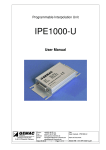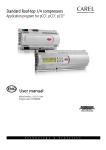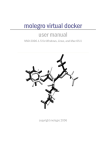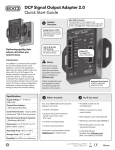Download USER MANUAL
Transcript
GALAMOST
GPU-Accelerated Large-Scale Molecular Simulation Toolkit
USER MANUAL
Version 0.0.3
Contents
Contents
1 Introduction ............................................................................... 1
1.1 A sketch of GALAMOST ..................................................................................... 1
2 Installation and Usage ............................................................... 3
2.1 Compiling and installation .................................................................................... 3
2.2 Usage by script ...................................................................................................... 3
2.3 Usage by user graphic interface ............................................................................ 6
3 Force Fields ............................................................................... 7
3.1 Short range non-bonded forces ............................................................................. 7
3.2 Bonded forces ....................................................................................................... 8
3.3 Numerical forces ................................................................................................. 10
4 Characteristic Models .............................................................. 12
4.1 Soft anisotropic particle model ........................................................................... 12
4.2 Polymerization model ......................................................................................... 13
4.3 Gay-Berne particle model ................................................................................... 13
5 Configuration Input ................................................................. 15
5.1 Coordinate file .................................................................................................... 15
5.2 Topologies ........................................................................................................... 16
6 Command Index ...................................................................... 18
6.1 Reading the initial configuration of system ........................................................ 18
6.1.1 Xml parser ................................................................................................. 18
6.1.2 Bin parser .................................................................................................. 18
6.2 Non-bonded forces .............................................................................................. 18
6.2.1 LJ force ..................................................................................................... 18
6.2.2 DPD force ................................................................................................. 19
6.2.3 Pair force for LJ12_6, LJ9_6, harmonic, Gauss ....................................... 20
6.2.4 External force ............................................................................................ 21
6.3 Bonded forces ..................................................................................................... 22
6.3.1 Bond harmonic force................................................................................. 22
6.3.2 Bond fene force ......................................................................................... 23
Contents
6.3.3 Bond polynomial force ............................................................................. 23
6.3.4 Angle harmonic force ................................................................................ 24
6.3.5 Angle cosine harmonic force .................................................................... 24
6.3.6 Angle cosine force..................................................................................... 25
6.3.7 Dihedral harmonic force ........................................................................... 26
6.3.8 Dihedral Opls Cosine force ....................................................................... 26
6.4 Integration method .............................................................................................. 27
6.4.1 Nve ensemble ............................................................................................ 27
6.4.2 Nvt ensemble with Nose Hoover method ................................................. 27
6.4.3 Nvt ensemble with Berendsen method ..................................................... 28
6.4.4 Nvt ensemble with Andersen method ....................................................... 28
6.4.5 Npt ensemble with Andersen barostat....................................................... 29
6.4.6 Nve rigid body thermostat ........................................................................ 30
6.4.7 Nvt rigid body thermostat ......................................................................... 30
6.4.8 Brownian dynamic nvt rigid body thermostat .......................................... 31
6.4.9 Nve rigid body thermostat with tunable freedoms .................................... 31
6.5 Particle Group ..................................................................................................... 32
6.5.1 Build group by keywords .......................................................................... 32
6.5.2 Build group by index range of particles .................................................... 33
6.5.3 Combine groups ........................................................................................ 33
6.6 Particle List ......................................................................................................... 33
6.6.1 Build neighbor list..................................................................................... 33
6.6.2 Build cell list ............................................................................................. 34
6.7 Data dump ........................................................................................................... 35
6.7.1 The dump of some important informations .............................................. 35
6.7.2 Configuration dump with mol2 format ..................................................... 35
6.7.3 Configuration dump with xml format ....................................................... 36
6.7.4 Configuration dump with dcd format ....................................................... 38
6.7.5 Configuration dump with binary format ................................................... 38
6.8 Some other functions .......................................................................................... 39
6.8.1 Removing the momentum of center of mass ............................................ 39
Contents
6.8.2 The computition of some important informations .................................... 39
6.8.3 Sorting data ............................................................................................... 40
6.8.4 VariantLinear............................................................................................. 40
6.8.5 VariantSin .................................................................................................. 41
6.8.6 VariantWell................................................................................................ 41
6.9 Some functional modules .................................................................................... 42
6.9.1 The coarse-graining numerical method .................................................... 42
6.9.2 The MD-SCF method ............................................................................... 44
6.9.3 The Polymerization method ...................................................................... 45
6.9.4 Anisotropic model ..................................................................................... 47
6.9.5 Gay-Berne model ...................................................................................... 48
6.10 Configuration generator .................................................................................... 50
6.11 Data tackle......................................................................................................... 55
7 Appended Documents .............................................................. 58
7.1 Polymerization model ......................................................................................... 58
Introduction
1 Introduction
1.1 A sketch of GALAMOST
GALAMOST is a versatile molecular simulation package which is designed
to utilize computational power of graphics processing units (GPUs) as much as
possible. In addition to common features of molecular dynamics programs, it is
developed specially for coarse-graining simulation of polymeric systems by
encompassing some latest techniques, such as hybrid particle-field molecular
dynamics, iterative Boltzmann inversion numerical potential method, soft
anisotropic particle model, and chain-growth polymerization model. By
continuously optimizing the algorithms, each method implemented on a single
GPU by GALAMOST has gained a good performance. Some biomolecules and
polymers can be modeled in coarse-grained MD (CGMD) simulations
implemented by GALAMOST. The CGMD has become a powerful tool,
accounting for the problems related to self-assembly, phase separation, and
other phenomena of polymeric systems.
The choices for general force field functions in GALAMOST will be listed
in the following sections. In addition, a hybrid particle field MD technique
(MD-SCF) for calculating intermolecular interactions has been incorporated in
GALAMOST. With this technique, the most computational time-consuming
parts in MD, i.e., the intermolecular pair interactions, are replaced by
interactions of particles with density fields. It will greatly speed up some slowly
evolving collective processes in MD simulations, such as micro-phase
separation and self-assembly of polymeric systems. In addition to analytical
potentials, numerical potential can be used in GALAMOST by reading the
potential table derived from iterative Boltzmann inversion (IBI) method or other
structure-based coarse-graining methods. The IBI method derives the
coarse-grained potentials by mapping the structural distributions onto the ones
obtained either from atomistic simulations or from experiments. With this
bottom-up coarse-graining scheme, the derived coarse-grained numerical
1
Introduction
potentials can be applied in larger systems, but under the same thermodynamic
conditions.
Besides some basic functions of general MD, such as CGMD, Brownian
dynamics (BD), and dissipative particle dynamics (DPD), GALAMOST also
encompasses several tailor-made modules: a soft anisotropic particle model has
been incorporated for modeling some kinds of anisotropic particles and a
stochastic chain-growth polymerization reaction model has been developed
specially for the studies related to polymerization. By using these advanced
simulation techniques on the GPU, GALAMOST enriches the routes for
researchers to investigate polymeric systems via computer simulations.
2
3
Installation and Usage
2 Installation and Usage
2.1 Compiling and installation
The entire GALAMOST package is a Free Software under the GNU General
Public License. The package is mainly distributed as source code and binary
program. The binary program of full version and the code of simplified version
can be downloaded from our website www.galamost.com. The full version of
code can be gotten by emailing to corresponding authors.
Here is the guide for installation by code. Before compiling and installing of
source code, you should set configuration firstly, i.e. installation path, by
following command.
./configuration --prefix=/opt/galamost
More configuration options are given here,
Commands
Functions
Examples
--prefix=
installation path
--prefix=/opt/galamost
--cuda_arch=
Compute capability of GPU
--cuda_arch=20
--precision=
precision format
--precision=double
--gprof=
profiling tool
--gprof=on
--gdb=
gdb tool
--gdb=on
After configuring, a Makefile will be generated in current directory. Then
you can compile and install the package by the following command,
make install -j4
where -j indicates the number of threads to compile the code.
2.2 Usage by script
The C++ and CUDA C code has been written as an extended module of
Python. We can use the functions of GALAMOST by loading and calling its
modules through a Python script.
Installation and Usage
With the prepared script, you should now be able to try running
GALAMOST as:
./dpd.gala --gpu=0 >a.log&
where you may specify the GPU id with the "--gpu=" option and output the
screen information into "a.log" file. If the script file has no executive
permission, the command of "chmod +x dpd.gala" should be executed before
running above command.
Here is an example of script. The head of GALAMOST script such as
"dpd.gala" usually is:
#!/usr/bin/python
import sys
sys.path.append('/opt/galamost/lib')
import galamost
global _options
parser = OptionParser()
parser.add_option('--gpu', dest='gpu',help='GPU on which to execute')
(_options, args) = parser.parse_args()
where the first paragraph sets the path of the installed library of GALAMOST
(galamost.so) for loading the Python extensible modules of GALAMOST. The
second paragraph is used for parsing GPU id from the executive command.
Then, by reading the configuration from a prepared XML file, a system with
necessary information can be built up by:
filename = 'A.xml'
build_method = galamost.XmlReader(filename)
perform_config = galamost.PerformConfig( int(_options.gpu))
all_info = galamost.AllInfo(build_method,perform_config)
After that, we need to build up an application which will call following
defined and added objects by:
4
Installation and Usage
dt = 0.01
app = galamost.Application(all_info, dt)
Further, we should define the needed objects by the classes of GALAMOST
and pass them to the application, such as the following example: non-bonded
DPD force, NVT thermostat with GWVV algorithm, and information analysis
methods:
neighbor_list = galamost.NeighborList(all_info, 1.0 ,0.05)#(,rcut,rbuffer)
dpd=galamost.DpdForce(all_info, neighbor_list, 1.0, 12345)#(,,rcut,seed)
dpd.setParams('A', 'A', 25.0, 3.0)#(,,alpha,sigma)
dpd.setParams('A', 'B', 40.0, 3.0)#( ,,alpha,sigma)
dpd.setParams('B', 'B', 25.0, 3.0)#( ,,alpha,sigma)
app.add(dpd)
group = galamost.ParticleSet(all_info, "all" )
comp_info = galamost.ComputeInfo(all_info, group)
Gwvv = galamost.DpdGwvv(all_info, group)
app.add(Gwvv)
dinfo = galamost.DumpInfo(all_info, comp_info, 'data.log')
dinfo.setPeriod(200)
app.add(dinfo)
The tail of script usually sets the freedom degree for "ComputeInfo" method,
the number of time steps to run, and the function of analysis of neighbor list etc.
comp_info.setNdof(app.getNdof())
app.run( 10000)
neighbor_list.printStats()
5
6
Installation and Usage
2.3 Usage by user graphic interface
Figure 2.1 The snapshot of UGI
User graphic interface (UGI) can directly run and display on personal
computer with Windows operation system and installed Python. UGI also can
run on remote workstation with Linux operation system and display on terminal
computer with Windows through Exceed or some other X server programs.
UGI is usually used to generate GALAMOST script. Before doing that, we
should choose a XML file which contains the necessary information of the
system, (i.e. particle types and bond types) to help building script. We can select
the functions of GALAMOST and set parameters by clicks and inputs. By
building a project, a window will be open to indicate the chosen items. With it,
you can cancel or reset parameters. At last, you can generate and output a
GALAMOST script.
7
Force Fields
3 Force Fields
3.1 Short range non-bonded forces
In polymer systems, the net non-bonded force of each particle is produced
by summing all the non-bonded forces of neighboring particles. The standard
algorithm is to use a neighbor list that lists the interacting particles for each
particle, built beforehand. Because of the independence of parallel CUDA
threads, a pair of interacting particles is inevitably included independently in
neighbor list in the mode that one thread calculates and sums all non-bonded
forces of a particle. The common non-bonded potential energy functions are
included in GALAMOST, which are
Lennard-Jones (LJ) (CI 6.2.1):
6
12
r 4
r
r
(3.1)
where 𝜖 is the depth of the potential well, 𝜎 is the finite distance at which the
interparticle potential is zero, and rij is the distance between the particles;
Harmonic repulsion (CI 6.2.3):
rij
1
U harmonic (rij ) 1
2 rcut
2
(3.2)
where α and rcut set the maximum energy penalty and maximum interaction
distance, respectively;
Gaussian repulsion (CI 6.2.3):
1 rij 2
U Gaussion (rij ) exp
2
(3.3)
8
Force Fields
where ε and σ determine the energy and length scales, respectively.
3.2 Bonded forces
The bonded forces generally include the bond, angle, and torsion forces.
Because of the execution mode of SIMD in GPU, it is efficient that a thread
calculates and sums the bond, angle, and torsion forces of a particle in the
kernel functions. Therefore, we can employ the thread whose number is equal to
the number of particle to calculate the bonded forces of each particle
independently. Although the force of a bond will be computed twice (three
times for an angle and four times for a torsion) on device, it casts the
computation well into parallel mode for separated threads of GPUs and is
efficient for data copy between host and device memories. The common bonded
potential energy functions in GALAMOST are
Bond harmonic (CI 6.3.1):
1
U bond (rij ) k bond (rij r0 )2
2
(3.4)
Bond FENE (CI 6.3.2):
rij 2
1 bond 2
U bond (rij ) k rm log(1 2 )
2
rm
(3.5)
Bond polynomial (CI 6.3.3):
Ubond (rij ) k1bond (rij r0 )2 k2bond (rij r0 )4
(3.6)
in which rij is the instantaneous length of the bond, r0 is the equilibrium length
of the bond, rm is maximum length, and kbond is the spring constant;
Angle harmonic (CI 6.3.4):
9
Force Fields
1
U angle (ijk ) k angle (ijk 0 )2
2
(3.7)
Angle cosine harmonic (CI 6.3.5):
1
U angle (ijk ) k angle cos ijk cos 0
2
2
(3.8)
Angle cosine (CI 6.3.6):
U angle (ijk ) k angle 1 cos ijk 0
(3.9)
in which 𝜃 ijk is the angle in radians between vectors rij and rjk, θ 0 is the
equilibrium angle, and kangle is the angle force constant;
Dihedral cosine (CI 6.3.7):
U dihedral (ijkl ) k dihedral 1 cos ijkl
(3.10)
Dihedral Opls (CI 6.3.8):
U dihedral (ijkl ) k1dihedral k2 dihedral 1 cos ijkl
k3dihedral 1 cos 2ijkl 2 k4 dihedral 1 cos 3ijkl 3 (3.11)
10
Force Fields
in which 𝜙ijkl is the angle in radians between the planes (i,j,k) and (j,k,l) which
is drawed in Fig. 3.1, 𝛿 is the phase shift angle, and kdihedral is the multiplicative
constant.
Figure 3.1 The schematic diagram of 𝜙ijkl
3.3 Numerical forces
The numerical non-bonded, bond, angle, and torsion potentials can be
derived from IBI or reverse Monte Carlo method. With IBI method, the
procedure starts with the potentials of mean force as guessed potentials and then
optimizes the potentials iteratively by mapping the structural distributions (i.e.,
radial distribution function, RDF) onto the ones obtained either from atomistic
simulations or from experiments. The resulting numerical potentials usually
take the form as a table in which the potential values at discrete grid points of
distance are given. In the treatment of tabulated potentials, the initial inputted
potential tables on grid points of r are transformed to the tables (arrays) on grid
points of z = r2. With this trick, the r = SQRT(r2) in the inner loop of force
calculation is avoided, and the force is then calculated by
F r
V (r ) 1
V ( z )
2r
r r
z
(3.12)
Within each interval between the grid points, potentials are fitted to a cubic
spline function, more specifically, for each xi < x < xi+1, let 𝛿 = x - xi , V(x) is
represented by
11
Force Fields
V ( x) c0 c1 c2 2 c3 3
(3.13)
where x corresponds to z, θ, and φ for particle-particle distance square, bending
angle, and torsion angle, respectively. i is the index of the grid point and c0 is
the starting potential value of each grid point. Other parameters c1 , c2 , and c3
are chosen to make the values of the first derivative and the second derivative at
both ends of interval xi and xi+1 equal to the correct values of function V.
12
Characteristic Models
4 Characteristic Models
4.1 Soft anisotropic particle model
By adding two degrees of freedom of rotation, our one-site anisotropic
particle model can be used to describe disk-like, rod-like, diblock and triblock
Janus particles. We have successfully examined the packing and the
self-assembly of anisotropic particles with this model.
In the simulations of disk-like and rod-like particles, we adopt a soft
anisotropic potential on the basis of the conservative potential in DPD. It can be
expressed as,
U ij (1 f )
ij
2
(1 rij )2
(3.14)
where the magnitude of 𝛼ij controls the strength of repulsion, μ controls the
shape of the particles, and υ controls the angular width of repulsion. The
disk-like or rod-like particle can be described by different expressions of
anisotropic factor f. In disk-like particle model, the anisotropic factor is
n r n
f
i
ij
j
rij
rij 2
(3.15)
where ni and nj are unit vectors assigning the orientations to particles i and j,
respectively. rij =ri -rj is the interparticle vector.
In rod-like particle model, the anisotropic factor is
f sin i sin j
(3.16)
where 𝜃i is the angle between ni and the interparticle vector rji = - rij , 𝜃j is the
angle between nj and rij.
13
Characteristic Models
4.2 Polymerization model
In this model, we consider free radical linear chain-growth polymerization,
that is, mA → −A −
m
for monomer A. Polymerization probability pr is set to
determine whether a monomer will react with an active end or not in a reaction
step and is coupled to the real reaction rate rp by
rp
d M
dt
P * Pr
(3.17)
where [M] is the free monomer concentration, [P*] is the concentration of
growth centers, and τ is the reaction time interval. In a time interval, if a
polymerization reaction event takes place between a monomer and an active
end, a bond connection should be added between them and then the active end
should be transferred to the new end.
4.3 Gay-Berne particle model
This model is usually used to describe ellipsoidal particles. Except for
translocation, the rotation of these anisotropic particles has to be considered.
Then, forces and torques are typically incorporated into molecular dynamics
simulation. The forces and torques are derived from Gay-Berne anisotropic
potential which is given here
012
06
V 4
Ps
12
6
r
r f
f
(3.18)
0s1 2
(3.19)
14
Characteristic Models
1
2 2
1 1 uˆ1 uˆ2
2
(3.20)
' rˆ uˆ1 rˆ uˆ2 rˆ uˆ1 rˆ uˆ2
2 1
2 1 ' uˆ1 uˆ2 1 ' uˆ1 uˆ2
2
2
rˆ uˆ rˆ uˆ rˆ uˆ rˆ uˆ
1
2
1
2
s 1
1 uˆ1 uˆ2
2 1 uˆ1 uˆ2
2
2
(3.21)
1
2
(3.22)
f 0 Ps
1/6
(3.23)
/ 1
e s 2
e / s 1
2
(3.24)
1 e / s
1/
'
1 e / s
1/
(3.25)
where e is end-to-end length, s is side-to-side length, e is end-to-end energy, and
s is side-to-side energy.
15
Configuration Input
5 Configuration Input
5.1 Coordinate file
We take XML format file as the standard inputting configuration file. The
*.xml file can contain types, masses, coordinates, velocities, topological
information, and so on.
Here is an example of XML file of 4 particles system. The position data in a
line (x, y, and z directions) locates a particle in box and one line corresponds to
one particle in sequence. This is also same rule for some other data, but do not
include topological information.
<?xml version="0.2" encoding="UTF-8"?>
<galamost_xml>
<configuration time_step="0">
<box units="sigma"
Lx="10" Ly="10" Lz="10"/>
<position units="sigma">
-1 2 -1
-2 3 0
-1 4 1
-1 5 2
</position>
<velocity units="sigma/tau">
123
100
3 -2 1
Configuration Input
011
</velocity>
<type>
A
B
B
A
</type>
<mass>
1.0
2.1
1.0
1.0
</mass>
</configuration>
</galamost_xml>
5.2 Topologies
<bond>
polymer 0 1
polymer 1 2
polymer 2 3
</bond>
Topological information also can be inputted to program by XML file. As
16
Configuration Input
above example, each bond connection should be given in one line. In addition
to bond connection, angle and dihedral information also should be given
explicitly in XML as following format, if they are needed.
<angle>
theta 0 1 2
theta 1 2 3
</angle>
<dihedral>
phi 0 1 2 3
</dihedral>
17
Command Index
6 Command Index
6.1 Reading the initial configuration of system
6.1.1 Xml parser
Constructor:
XmlReader(const std::string &)
#note: specifies the XML file parser method
#parameter: XML file name
Example:
filename = 'dppc.xml'
#sets the name of inputting XML file
build_method = galamost.XmlReader(filename)
#builds up the reading object of inputting XML file
6.1.2 Bin parser
Constructor:
BinaryReader(const std::string &)
#note: specifies the GALAMOST binary file parser method
#parameter: binary file name
Example:
filename = 'initial.bin'
#sets the name of GALAMOST binary file
build_method = galamost.BinaryReader(filename)
#builds up the reading object of inputting GALAMOST binary file
6.2 Non-bonded forces
6.2.1 LJ force
Constructor:
LjForce(boost::shared_ptr<AllInfo>, boost::shared_ptr<NeighborList>, Real)
#note: specifies the LJ pair force
18
Command Index
19
#parameters: AllInfo, NeighborList, cut-off radius of interaction
Functions:
void setParams(const std::string &, const std::string &, Real, Real, Real)
#note: specifies the LJ interaction parameters by pair types
#parameters: type 1, type 2, epsilon, sigma, alpha
void setParams(const std::string &, const std::string &, Real, Real, Real, Real)
#note: specifies the LJ interaction parameters by pair types
#parameters: type 1, type 2, epsilon, sigma, alpha, cut-off of radius
void setEnergy_shift()
# note: calls the function to shift LJ potential to be zero at the cut-off point
Example:
lj = galamost.LjForce(all_info, neighbor_list, 3.0)
#initializes LjForce object by: AllInfo object, NeighborList object, cut-off
lj.setParams('A', 'A' , 1.0, 1.0, 1.0)
#sets parameters: particle type 1, particle type 2, epsilon, sigma, alpha
lj.setEnergy_shift()
#shifts LJ potential to be zero at cut-off
app.add(lj)
#adds this object to the application
6.2.2 DPD force
Constructor:
DpdForce(boost::shared_ptr<AllInfo>, boost::shared_ptr<NeighborList>,
Real, Real, unsigned int)
#note: specifies the DPD pair force
#parameters: AllInfo, NeighborList, cut-off of radius, temperature, RNG seed
DpdForce(boost::shared_ptr<AllInfo>, boost::shared_ptr<NeighborList>,
Real, unsigned int)
#note: specifies the DPD pair force (the defalt temperature is 1.0)
#parameters: AllInfo, NeighborList, cut-off of radius, RNG seed
Functions:
void setParams(const std::string &, const std::string &, Real, Real)
20
Command Index
#note: specifies the DPD interaction parameters by pair types
#parameters: type1, type2, alpha, sigma
void setT(Real)
#note: specifies the temperature
#parameters: a constant value of temperature
void setT(boost::shared_ptr<Variant>)
#note: specifies the temperature
#parameters: a varing temperature according to time steps
void setDPDVV()
#note: calls the function to enable DPDVV method (the default is GWVV)
Example:
dpd = galamost.DpdForce(all_info, neighbor_list, 1.0, 12345)
#initializes DpdForce object by: AllInfo object, NeighborList object, cut-off,
RNG seed
dpd.setParams('A', 'A', 25.0, 3.0)
#sets parameters by: particle type 1, particle type 2, alpha, sigma
app.add(dpd)
#adds this object to the application
6.2.3 Pair force for LJ12_6, LJ9_6, harmonic, Gauss
Constructor:
PairForce (boost::shared_ptr<AllInfo>, boost::shared_ptr<NeighborList>)
#note: specifies the pair force
#parameters: AllInfo, NeighborList
Functions:
void setParams(const std::string &, const std::string &, Real, Real, Real, Real,
Func)
#note: specifies the pair interaction type and parameters by pair types
#parameters: type1, type2, parameter0, parameter1, parameter2, cut-off,
function type
Function type
Parameter 0
Parameter 1
Parameter 2
21
Command Index
lj12_6
epsilon
sigma
alpha
lj9_6
epsilon
sigma
alpha
harmonic
alpha
gauss
epsilon
sigma
Example:
pair = galamost. PairForce (all_info, neighbor_list)
#initializes PairForce object by: AllInfo object, NeighborList object
pair.setParams('A', 'A', 1.0, 1.0, 1.0, 3.0, galamost.PairForce.Func. lj12_6)
#sets parameters by: type 1, type 2, epsilon, sigma, alpha, LJ12_6 function
pair.setParams('A', 'B', 1.0, 1.0, 1.0, 3.0, galamost.PairForce.Func. lj9_6)
#sets parameters by: type 1, type 2, epsilon, sigma, alpha, LJ9_6 function
pair.setParams('B', 'B', 1.0, 1.0, 1.0, 3.0, galamost.PairForce.Func. lj12_6)
#sets parameters by: type 1, type 2, epsilon, sigma, alpha, LJ12_6 function
app.add(pair)
#adds this object to the application
6.2.4 External force
Constructor:
ExternalForce(boost::shared_ptr<AllInfo>, boost::shared_ptr<ParticleSet>);
#note: specifies the external force for the group particles
#parameters: AllInfo, ParticleSet
Functions:
void setForce (boost::shared_ptr<Variant>, std::string)
#note: specifies the force magnitude varing by time steps and direction
#parameters: Variant and direction (candidates are “X”, “Y”, and “Z”)
void setForce (boost::shared_ptr<Variant>, Real, Real, Real)
#note: specifies the force magnitude varing by time steps and direction
#parameters: Variant and directional vector with x, y, and z
void setParams(const std::string &, Real)
#note: specifies the factor multiplied by the external force
#parameters: particle type, factor
Command Index
void setParams(unsigned int, Real)
#note: specifies the factor multiplied by the external force
#parameters: particle index, factor
Example:
v = galamost. VariantSin ()
v.setPoint(0, 1000, 1, -1)
v.setPoint(1000000, 1000, 1, -1)
#set the parameters of sinesoid force by timestep, period, max and min value.
The latter three paramters are linearly varing by timestep
groupA = galamost.ParticleSet(all_info,”A”)
ef = galamost. ExternalForce (all_info, groupA)
#initializes ExternalForce object by: AllInfo object, ParticleSet object
ef. setForce (v, “X”)
#sets parameters by: force and direction
app.add(ef)
#adds this object to the application
6.3 Bonded forces
6.3.1 Bond harmonic force
Constructor:
BondForceHarmonic(boost::shared_ptr<AllInfo>)
#note: specifies the harmonic bond force
#parameter: AllInfo
Functions:
void setParams(const std::string &, Real, Real)
#note: specifies the harmonic bond interaction parameters of different types
#parameters: bond type, spring constant, equilibrium length
Example:
bondforce = galamost.BondForceHarmonic(all_info)
#initializes BondForceHarmonic object by: AllInfo object
bondforce.setParams('polymer', 1250.000, 0.470)
22
Command Index
#sets parameters by: bond type, spring constant, equilibrium bond length
app.add(bondforce)
#adds this object to the application
6.3.2 Bond fene force
Constructor:
BondForceFene (boost::shared_ptr<AllInfo>)
#note: specifies the FENE bond force
#parameter: AllInfo
Functions:
void setParams(const std::string &, Real, Real)
#note: specifies the FENE bond force parameters
#parameters: bond type, spring constant, maximum length of the bond
void setParams(const std::string &, Real, Real , Real, Real)
#note: specifies the FENE+LJ bond parameters
#parameters: bond type, spring constant, maximum length of the bond,
epsilon, sigma
Example:
bondforcefene = galamost.BondForceFene(all_info)
#initializes BondForceFene object by: AllInfo object
bondforcefene.setParams('polymer', 10, 1.2)
#sets parameters by: bond type, spring constant, maximum length of the bond
app.add(bondforcefene)
#adds this object to the application
6.3.3 Bond polynomial force
Constructor:
BondForcePolynomial (boost::shared_ptr<AllInfo>)
#note: specifies the polynomial bond force
#parameter: AllInfo
Functions:
void setParams(const std::string &, Real, Real, Real)
23
Command Index
#note: specifies the polynomial bond force parameters
#parameters: bond type, spring constant k1, spring constant k2, equilibrium
bond length
Example:
bondforcepolynomial = galamost. BondForcePolynomial (all_info)
#initializes BondForceFene object by: AllInfo object
bondforcepolynomial.setParams('polymer', 10.0, 100.0, 1.2)
#sets parameters by: bond type, spring constant, spring constant, equilibrium
bond length
app.add(bondforcepolynomial)
#adds this object to the application
6.3.4 Angle harmonic force
Constructor:
AngleForceHarmonic(boost::shared_ptr<AllInfo>)
#note: specifies the angle harmonic force
#parameter: AllInfo
Functions:
void setParams(const std::string &, Real, Real)
#note: specifies the angle harmonic force parameters
#parameters: angle type, spring constant, equilibrium angle degree
Example:
angleforce = galamost.AngleForceHarmonic(all_info)
#initializes AngleForceHarmonic object by: AllInfo object
angleforce.setParams('P-G-G', 25.000, 120.000)
#sets parameters by: angle type, spring constant, equilibrium degree
app.add(angleforce)
#adds this object to the application
6.3.5 Angle cosine harmonic force
Constructor:
AngleForceHarmonicCos (boost::shared_ptr<AllInfo>)
24
Command Index
#note: specifies the angle cosine harmonic force
#parameter: AllInfo
Functions:
void setParams(const std::string &, Real, Real)
#note: specifies the angle cosine harmonic force parameters
#parameters: angle type, spring constant, equilibrium angle degree
Example:
angleforce = galamost.AngleForceHarmonicCos(all_info)
#initializes AngleForceHarmonic object by: AllInfo object
angleforce.setParams('P-G-G', 25.000, 120.000)
#sets parameters by: angle type, spring constant, equilibrium degree
app.add(angleforce)
#adds this object to the application
6.3.6 Angle cosine force
Constructor:
AngleForceCos (boost::shared_ptr<AllInfo>)
#note: specifies the angle cosine force
#parameter: AllInfo
Functions:
void setParams(const std::string &, Real, Real)
#note: specifies the angle cosine force parameters
#parameters: angle type, spring constant, equilibrium angle degree
Example:
angleforce = galamost.AngleForceCos(all_info)
#initializes AngleForceCos object by: AllInfo object
angleforce.setParams('P-G-G', 25.000, 120.000)
#sets parameters by: angle type, spring constant, equilibrium degree
app.add(angleforce)
#adds this object to the application
25
Command Index
26
6.3.7 Dihedral harmonic force
Constructor:
DihedralForceHarmonic(boost::shared_ptr<AllInfo>)
#note: specifies the dihedral harmonic force
#parameter: AllInfo
Functions:
void setParams(const std::string &, Real, Real)
#note: specifies the dihedral harmonic force parameters
#parameters: dihedral type, spring constant, equilibrium dihedral degree
Example:
dihedralforce = galamost. DihedralForceHarmonic (all_info)
#initializes DihedralForceHarmonic object by: AllInfo object
dihedralforce.setParams('A-B-B-A', 10.0, 0.0)
#sets parameters by: dihedral type, spring constant, equilibrium degree
app.add(dihedralforce)
#adds this object to the application
6.3.8 Dihedral Opls Cosine force
Constructor:
DihedralForceOplsCosine (boost::shared_ptr<AllInfo>)
#note: specifies the dihedral opls cosine force
#parameter: AllInfo
Functions:
void setParams(const std::string &, Real, Real, Real, Real, Real)
#note: specifies the dihedral opls cosine force parameters
#parameters: dihedral type, C0, C1, C2, C3, equilibrium dihedral degree
Example:
dihedralforce = galamost.DihedralForceOplsCosine(all_info)
#initializes DihedralForceOplsCosine object by: AllInfo object
dihedralforce.setParams('C_33-C_32-C_32-C_32', 0.0, 2.95188, -0.566963,
6.57940, 0.0)
Command Index
27
#sets parameters by: dihedral type, C0, C1, C2, C3, equilibrium dihedral degree
app.add(dihedralforce)
#adds this object to the application
6.4 Integration method
6.4.1 Nve ensemble
Constructor:
Nve(boost::shared_ptr<AllInfo>, boost::shared_ptr<ParticleSet>)
#note: specifies the NVE thermostat of a group of particles
#parameter: AllInfo, ParticleSet
Functions:
void setZeroForce(bool)
#note: switches the function of making all force to be zero
#parameters: True or False (the default is False)
Example:
thermo = galamost.Nve(all_info, group)
#initializes Nve object by: AllInfo object, ParticleSet object
app.add(thermo)
#adds this object to the application
6.4.2 Nvt ensemble with Nose Hoover method
Constructor:
NoseHooverNvt(boost::shared_ptr<AllInfo>, boost::shared_ptr<ParticleSet>,
boost::shared_ptr<ComputeInfo>, Real, Real)
#note: specifies the NVT NoseHoover thermostat of a group of particles
#parameter: AllInfo, ParticleSet, ComputeInfo, temperature, tauT
Functions:
void setT(Real)
#note: specifies the temperature
#parameters: a fixed value of temperature
void setT(boost::shared_ptr<Variant>)
Command Index
#note: specifies the temperature
#parameters: a defined varing temperature according to time steps
Example:
nh = galamost.NoseHooverNvt(all_info, group, comp_info, 1.0, 0.5)
#initializes NoseHooverNvt object by: AllInfo object, ParticleSet object,
ComputeInfo object, temperature, tauT
app.add(nh)
#adds this object to the application
6.4.3 Nvt ensemble with Berendsen method
Constructor:
BerendsenNvt (boost::shared_ptr<AllInfo>, boost::shared_ptr<ParticleSet>,
boost::shared_ptr<ComputeInfo>, Real, Real)
#note: specifies the NVT Berendsen thermostat of a group of particles
#parameter: AllInfo, ParticleSet, ComputeInfo, temperature, tauT
Functions:
void setT(Real)
#note: specifies the temperature
#parameters: a fixed value of temperature
void setT(boost::shared_ptr<Variant>)
#note: specifies the temperature
#parameters: a defined varing temperature according to time steps
6.4.4 Nvt ensemble with Andersen method
Constructor:
AndersenNvt (boost::shared_ptr<AllInfo>, boost::shared_ptr<ParticleSet>,
Real, Real, unsigned int)
#note: specifies the NVT Andersen thermostat of a group of particles
#parameter: AllInfo, ParticleSet, temperature, collision frequency, RNG seed
Functions:
void setT(Real)
#note: specifies the temperature
28
Command Index
#parameters: a fixed value of temperature
void setT(boost::shared_ptr<Variant>)
#note: specifies the temperature
#parameters: a defined varing temperature according to time steps
Example:
an = galamost. AndersenNvt (all_info, group, 1.0, 10.0, 12345)
#initializes AndersenNvt object by: AllInfo object, ParticleSet object,
temperature, collision frequency, RNG seed
app.add(an)
#adds this object to the application
6.4.5 Npt ensemble with Andersen barostat
Constructor:
Npt(boost::shared_ptr<AllInfo>, boost::shared_ptr<ParticleSet>,
boost::shared_ptr<ComputeInfo>, boost::shared_ptr<ComputeInfo>, Real,
Real, Real, Real)
#note: specifies the NPT thermostat of a group of particles
#parameter: AllInfo, ParticleSet, ComputeInfo, ComputeInfo, temperature,
pressure, tauT, tauP
Functions:
void setP(Real)
#note: specifies the pressure
#parameters: a fixed value of pressure
void setT(Real)
#note: specifies the temperature
#parameters: a fixed value of temperature
void setT(boost::shared_ptr<Variant>)
#note: specifies the temperature
#parameters: a defined varing temperature according to time steps
Example:
npt = galamost.Npt(all_info, group, comp_info, comp_info, 1.0, 0.2, 0.5, 0.1)
#initializes Npt object by: AllInfo object, ParticleSet object, ComputeInfo
29
Command Index
30
object for the group, ComputeInfo object for all particles, temperature,
pressure, tauT, tauP)
app.add(npt)
#adds this object to the application
6.4.6 Nve rigid body thermostat
Constructor:
NveRigid(boost::shared_ptr<AllInfo>, boost::shared_ptr<ParticleSet>)
#note: specifies the NVE thermostat of rigid bodies
#parameter: AllInfo, ParticleSet
Example:
rigidnve = galamost.NveRigid(all_info, bgroup)
#initializes NveRigid object by: AllInfo object, ParticleSet object
app.add(rigidnve)
#adds this object to the application
6.4.7 Nvt rigid body thermostat
Constructor:
NveRigid(boost::shared_ptr<AllInfo>, boost::shared_ptr<ParticleSet>)
#note: specifies the NVE thermostat of rigid bodies
#parameter: AllInfo, ParticleSet
Functions:
void setT(Real)
#note: specifies the temperature
#parameters: a fixed value of temperature
void setT(boost::shared_ptr<Variant>)
#note: specifies the temperature
#parameters: a defined varing temperature according to time steps
Example:
rigidnvt = galamost.NvtRigid(all_info, bgroup, 1.0, 10.0)
#initializes NvtRigid object by: AllInfo object, ParticleSet object, temperature,
tau
Command Index
app.add(rigidnvt)
#adds this object to the application
6.4.8 Brownian dynamic nvt rigid body thermostat
Constructor:
BdNvtRigid(boost::shared_ptr<AllInfo>, boost::shared_ptr<ParticleSet>,
Real, unsigned int)
#note: specifies the Brownian NVT thermostat of rigid bodies
#parameter: AllInfo, ParticleSet, temperature RNG seed
Functions:
void setGamma(Real)
#note: specifies the gamma of Brownian method
#parameters: a fixed value of gamma
void setGamma(const std::string &, Real)
#note: specifies the gamma of Brownian method of different types
#parameters: type, gamma
void setT(Real)
#note: specifies the temperature
#parameters: a fixed value of temperature
void setT(boost::shared_ptr<Variant>)
#note: specifies the temperature
#parameters: a defined varing temperature according to time steps
Example:
bdrigidnvt = galamost. BdNvtRigid(all_info, bgroup, 1.0, 123)
#initializes BdNvtRigid object by (AllInfo object, ParticleSet object,
temperature, RNG seed)
app.add(bdrigidnvt)
#adds this object to the application
6.4.9 Nve rigid body thermostat with tunable freedoms
Constructor:
TranRigid(boost::shared_ptr<AllInfo>, boost::shared_ptr<ParticleSet>)
31
Command Index
#note: specifies the NVE thermostat of rigid bodies in defined freedoms
#parameter: AllInfo, ParticleSet
Functions:
void setTraDimention(bool, bool, bool)
#note: switches the freedoms of translocation in x y z directions
#parameters: True or False for x y z translocation, respectively
void setRotDimention(bool, bool, bool)
#note: switches the freedoms of rotation in x y z directions
#parameters: True or False for x y z rotation, respectively
Example:
bdrigidnvt = galamost.TranRigid (all_info, bgroup)
#initializes TranRigid object by: AllInfo object, ParticleSet object
bdrigidnvt.setTraDimention(True, True, True)
#switches the freedoms of translocation in x y z directions
bdrigidnvt.setRotDimention(True, True, True)
#switches the freedoms of rotation in x y z directions
app.add(bdrigidnvt)
#adds this object to the application
6.5 Particle Group
6.5.1 Build group by keywords
Constructor:
ParticleSet(boost::shared_ptr<AllInfo>, const std::string&)
#note: specifies the group of particles by keywords
#parameter: AllInfo, keywords
Example:
groupC = galamost.ParticleSet(all_info, 'C')
#initializes ParticleSet object by: AllInfo object, particle type
groupB = galamost.ParticleSet(all_info, 'body')
#initializes ParticleSet object of body particles by: AllInfo object, key word
groupNB= galamost.ParticleSet(all_info, 'non_body')
32
Command Index
#initializes ParticleSet object of nonbody particles by: AllInfo object, key
word
groupC = galamost.ParticleSet(all_info, 'all')
#initializes ParticleSet object of all particles by: AllInfo, key word
6.5.2 Build group by index range of particles
Constructor:
ParticleSet(boost::shared_ptr<AllInfo>, unsigned int, unsigned int)
#note: specifies the group of particles in a range of indexes
#parameter: AllInfo, minimum index, maximum index
Example:
groupC = galamost.ParticleSet(all_info, 0, 10)
#initializes ParticleSet object by: AllInfo object, min particle index, max
particle index
6.5.3 Combine groups
Functions:
boost::shared_ptr<ParticleSet> combine(boost::shared_ptr<ParticleSet> ,
boost::shared_ptr<ParticleSet> )
#note: combines two groups into one
#parameter: ParticleSet, ParticleSet
Example:
groupAB= galamost.ParticleSet. combine (groupA, groupB)
#initializes ParticleSet object by: ParticleSet object, ParticleSet object
6.6 Particle List
6.6.1 Build neighbor list
Constructor:
NeighborList(boost::shared_ptr<AllInfo>, Real, Real)
#note: specifies the neighbor list of all particles
#parameters: AllInfo, cut-off, buffer distance
33
Command Index
Functions:
void setRCut(Real, Real)
#note: specifies the cut-off and buffer distance
#parameters: cut-off, buffer distance
void setNsq()
#note: switches on the method of searching all particles to build up list
void setDataReproducibility()
#note: switches on the data reproducibility
Example:
neighbor_list = galamost.NeighborList(all_info, 3.0 ,0.4)
#initializes NeighborList object by: AllInfo object, cut off, buffer distance
6.6.2 Build cell list
Constructor:
CellList(boost::shared_ptr<AllInfo>)
#note: specifies the cell list of all particles
#parameter: AllInfo
Functions:
void setNominalWidth (Real)
#note: specifies the length of cell
#parameters: the length of cell
void setNominalDim(unsigned int, unsigned int, unsigned int)
#note: specifies the dimentions of grid in x, y, z directions, respectively
#parameters: the number of cells in x, y, z directions
void setDataReproducibility()
#note: switches on the data reproducibility function
Example:
cell_list = galamost.CellList(all_info);
#initializes CellList object by: AllInfo object
34
Command Index
6.7 Data dump
6.7.1 The dump of some important informations
Constructor:
DumpInfo(boost::shared_ptr<AllInfo> , boost::shared_ptr<ComputeInfo>,
const std::string&)
#note: specifies the information dump method of a group of particles
#parameters: AllInfo, ComputeInfo, file name
Functions:
void dumpAnisotropy()
#note: switches on the dump of information related to anisotropic particles
void dumpVirialEnergy(boost::shared_ptr<Force>)
#note: switches on the dump of energy and virial of inputting force object
#parameters: Force object
Example:
dInfo = galamost.DumpInfo(all_info, comp_info, 'data.log')
#initializes DumpInfo object by: AllInfo object, ComputeInfo object, file
name
dInfo.setPeriod(200)
#sets dump period
app.add(dInfo)
#adds this object to the application
6.7.2 Configuration dump with mol2 format
Constructor:
Mol2Dump(boost::shared_ptr<AllInfo>, std::string)
#note: specifies the dump method of mol2 files
#parameters: AllInfo, file name
Functions:
void setChangeFreeType(const std::string&)
#note: specifies the type of free particles which will be changed to be 'F'
35
Command Index
void deleteBoundaryBond(bool)
#note: switches on the function of undisplaying the bonds across the box
Example:
mol2 = galamost.Mol2Dump(all_info, 'particles')
#initializes Mol2Dump object by: AllInfo object, base file name
mol2.setPeriod(100000)
#sets dump period
mol2.deleteBoundaryBond(True)
#undisplays the bonds which across the box
app.add(mol2)
#adds this object to the application
6.7.3 Configuration dump with xml format
Constructor:
XmlDump(boost::shared_ptr<AllInfo>, std::string)
#note: specifies the dump method of XML files
#parameters: AllInfo, base file name
Functions:
void setOutputPosition(bool)
#note: switches the function of outputing position (the default is true)
void setOutputType (bool)
#note: switches the function of outputing type (the default is true)
void setOutputImage (bool)
#note: switches the function of outputing image
void setOutputVelocity (bool)
#note: switches the function of outputing velocity
void setOutputMass (bool)
#note: switches the function of outputing mass
void setOutputCharge (bool)
#note: switches the function of outputing charge
void setOutputDiameter (bool)
#note: switches the function of outputing diameter
36
Command Index
void setOutputBody (bool)
#note: switches the function of outputing body
void setOutputVirial (bool)
#note: switches the function of outputing virial
void setOutputForce (bool)
#note: switches the function of outputing force
void setOutputOrientation (bool)
#note: switches the function of outputing orientation
void setOutputQuaternion (bool)
#note: switches the function of outputing quaternion
void setOutputRotation (bool)
#note: switches the function of outputing rotation velocity
void setOutputTorque (bool)
#note: switches the function of outputing torque
void setOutputInert (bool)
#note: switches the function of outputing inert tensor
void setOutputInit (bool)
#note: switches the function of outputing initiator indication
void setOutputCris (bool)
#note: switches the function of outputing cris
void setOutputBond (bool)
#note: switches the function of outputing bond
void setOutputAngle (bool)
#note: switches the function of outputing angle
void setOutputDihedral (bool)
#note: switches the function of outputing dihedral
Example:
xml = galamost.XmlDump(all_info, 'particles')
#initializes XmlDump by: AllInfo object, filename
xml.setPeriod(100000)
#sets dump period
37
Command Index
app.add(xml)
#adds this object to the application
6.7.4 Configuration dump with dcd format
Constructor:
DcdDump(boost::shared_ptr<AllInfo>, const std::string &, bool)
#note: specifies the dump method of DCD file
#parameters: AllInfo, file name, overwrite former data
Functions:
void removePbc(bool)
#note: switches the function of unwrapping the molecules folded by PBC
Example:
dcd = galamost.DcdDump(all_info, 'particles',True)
#initializes XmlDump object by: AllInfo object, filename, overwriting
dcd.removePbc(True)
#unwraps the molecules folded by PBC
dcd. DcdDump (100000)
#sets dump period
app.add(dcd)
#adds this object to the application
6.7.5 Configuration dump with binary format
Constructor:
DcdDump(boost::shared_ptr<AllInfo>, const std::string &, bool)
#note: specifies the dump method of DCD file
#parameters: AllInfo, file name, overwrite former data
Functions:
void setOutputAll()
#note: switches on the function of outputing all data
void setOutputForRestart()
#note: switches on the function of outputing data needed for restarting
void enableCompression(bool)
38
Command Index
#note: switches the function of compressing output file
Example:
binary = galamost.BinaryDump(all_info, 'particle')
#initializes BinaryDump object by: AllInfo object, filename
binary.setPeriod(10000)
#sets dump period
app.add(binary)
#adds this object to the application
6.8 Some other functions
6.8.1 Removing the momentum of center of mass
Constructor:
ZeroMomentum(boost::shared_ptr<AllInfo>)
#note: specifies the method of making the momentum of center mass of all
particles to be zero
#parameter: AllInfo
ZeroMomentum(boost::shared_ptr<AllInfo>, boost::shared_ptr<ParticleSet>)
#note: specifies the method of making the momentum of center mass of a
group of particles to be zero
Example:
zm = galamost.ZeroMomentum(all_info)
#initializes ZeroMomentum object by: AllInfo object
zm.setPeriod(10)
#sets computing period
app.add(zm)
#adds this object to the application
6.8.2 The computition of some important informations
Constructor:
ComputeInfo(boost::shared_ptr<AllInfo>, boost::shared_ptr<ParticleSet>)
#note: specifies the method of dumping some important information
39
Command Index
#parameters: AllInfo, ParticleSet
Functions:
void setNdof(unsigned int)
#note: sets the freedom degree
Example:
comp_info = galamost.ComputeInfo(all_info, group)
#initializes ComputeInfo object by: AllInfo object, ParticleSet object
6.8.3 Sorting data
Constructor:
ComputeInfo(boost::shared_ptr<AllInfo>, boost::shared_ptr<ParticleSet>)
#note: specifies the method of dumping some important information
#parameters: AllInfo, ParticleSet
Example:
sort_method = galamost.Sort(all_info)
#initializes Sort object by: AllInfo object
sort_method.setPeriod(300)
#sets computing period
app.add(sort_method)
#adds this object to the application
6.8.4 VariantLinear
Constructor:
VariantLinear ()
#note: specifies linearly varing method
Functions:
void setPoint(unsigned int, double)
#note: specifies the value at the time step
#parameters: time step, value
Example:
v = galamost.VariantLinear()
#initializes VariantLinear object
40
Command Index
41
v. setPoint (0, 1.0)
v. setPoint (100000, 2.0)
#set the value at the time step and the value at any time step can be gotten by
linear interpolation.
6.8.5 VariantSin
Constructor:
VariantSin ()
#note: specifies sinusoidal curve varing method
Functions:
void setPoint(unsigned int, double, double, double)
#note: specifies the period, upper, and lower bounds at the time step
#parameters: time step, period, upper, and lower bounds
Example:
v = galamost.VariantSin ()
#initializes VariantSin object
v. setPoint (0, 1000, 1.0, -1.0)
v. setPoint (100000, 1000, 2.0, -2.0)
#set the parameters of sinusoid at the time step and the parameters at any time
step can be gotten by linear interpolation.
6.8.6 VariantWell
Constructor:
VariantWell()
#note: specifies well curve varing method
Functions:
void setPoint(unsigned int, double, double, double)
#note: specifies the period, upper, and lower bounds at the time step
#parameters: time step, period, upper, and lower bounds
Example:
v = galamost.VariantWell ()
#initializes VariantWell object
Command Index
42
v. setPoint (0, 1000, 1.0, -1.0)
v. setPoint (100000, 1000, 1.0, -1.0)
#set the parameters of periodic well at the time step and the parameters at any
time step can be gotten by linear interpolation.
6.9 Some functional modules
6.9.1 The coarse-graining numerical method
1) Non-bonded interaction:
Constructor:
PairForceTable(boost::shared_ptr<AllInfo>, boost::shared_ptr<NeighborList>,
unsigned int)
#note: specifies the method of numerical pair force
#parameters: AllInfo, NeighborList, the number of potential points
Functions:
void setParams(const std::string &, const std::string &, Real, const std::string
&, int, int)
#note: specifies the numerical pair interaction parameters by pair types
#parameters: type 1, type 2, cut-off, inputting file name, start column, end
column
Example:
pair = galamost.PairForceTable(all_info, neighbor_list, 1.3, 2000)
#initializes PairForceTable object by: AllInfo object, NeighborList object, cut
off, the number of inputting data
pair.setParams('A', 'A' ,1.3, "table.dat", 0, 3)
#sets parameters by: type 1, type 2, cut-off, inputting file name, start column,
end column (four columns for C1 C2 C3 C4)
app.add(pair)
#adds this object to the application
2) Bond interaction:
Constructor:
BondForceTable(boost::shared_ptr<AllInfo>, Real, unsigned int)
Command Index
#note: specifies the method of numerical bond force
#parameters: AllInfo, cut-off, the number of potential points
Functions:
void setParams(const std::string &, const std::string &, int ,int)
#note: specifies the numerical bond interaction parameters by bond types
#parameters: bond type, inputting file name, start column, end column
Example:
bond = galamost.BondForceTable(all_info, 2.0, 2000)
#initializes BondForceTable object by :AllInfo object, cut off, data number
bond.setParams('1_1' , "table.dat", 0, 3)
#sets parameters by: bond type, cut-off, inputting file, start column, end
column
app.add(bond)
#adds this object to the application
3) Angle interaction:
Constructor:
AngleForceTable(boost::shared_ptr<AllInfo>, unsigned int)
#note: specifies the method of numerical angle force
#parameters: AllInfo, the number of potential points
Functions:
void setParams(const std::string &, const std::string &, int ,int)
#note: specifies the numerical angle force parameters by bond types
#parameters: angle type, inputting file name, start column, end column
Example:
angle = galamost.AngleForceTable(all_info, 500)
#initializes AngleForceTable object by: AllInfo object, data number
angle.setParams('111' , "table.dat", 0, 3)
#sets parameters by: angle type, inputting file, start column, end column
app.add(angle)
#adds this object to the application
4) Dihedral interaction
43
Command Index
Constructor:
DihedralForceTable (boost::shared_ptr<AllInfo>, unsigned int)
#note: specifies the method of numerical dihedral force
#parameters: AllInfo, the number of potential points
Functions:
void setParams(const std::string &, const std::string &, int ,int)
#note: specifies the numerical dihedral force parameters by dihedral types
#parameters: dihedral type, inputting file name, start column, end column
Example:
dihedral = galamost. DihedralForceTable (all_info, 500)
#initializes DihedralForceTable object by: AllInfo object, data number
dihedral.setParams('111' , "table.dat", 0, 3)
#sets parameters by: dihedral type, inputting file, start column, end column
app.add(dihedral)
#adds this object to the application
6.9.2 The MD-SCF method
Constructor:
MdScfForce(boost::shared_ptr<AllInfo>, unsigned int , unsigned int,
unsigned int, Real)
#note: specifies the method of MD-SCF force
#parameters: AllInfo, grid number in x, y, z, direction, compressibility
Functions:
void setParams(const std::string &, const std::string &, Real)
#note: specifies the MD-SCF interaction parameters by pair types
#parameters: type 1, type 2, χ parameter
void setNewVersion(bool)
#note: switches the function of newly developed method of implementation
Example:
scf = galamost.MdScfForce(all_info, 22, 22, 22, 0.100)
#initializes MdScfForce object by: AllInfo object, grid number in x, y, z
directions, compressibility
44
Command Index
45
scf.setParams('N', 'N', 0.000)
#sets parameters by: type1, type 2, χ parameters
scf.setParams('N', 'P', -1.500)
#sets parameters by: type1, type 2, χ parameters
scf.setParams('P', 'P', 0.000)
#sets parameters by: type1, type 2, χ parameters
scf.setPeriodScf(1, 300)
#sets parameters by: computing period of density field, updating period of
density field
scf.setNewVersion(True)
#switches to newly developed version
app.add(scf)
#adds this object to the application
6.9.3 The Polymerization method
Constructor:
Polymerization(boost::shared_ptr<AllInfo>, boost::shared_ptr<NeighborList>,
Real, unsigned int)
#note: specifies the method of polymerization
#parameters: AllInfo, NeighborList, cut-off, RNG seed
Polymerization(boost::shared_ptr<AllInfo>, const std::string &, Real,
boost::shared_ptr<NeighborList>, Real, unsigned int)
#note: specifies the method of polymerization with a percent of initiator
#parameters: AllInfo, type, percent, NeighborList, cut-off, RNG seed
Functions:
void setPr(Real)
#note: specifies the reaction probability
void setPr(const std::string&, const std::string&, Real)
#note: specifies the reaction probability between two kind particles
#parameters: particle type 1, particle type 2, probability
void setPrFactor (Real)
#note: specifies the reaction probability factor of factorn where n is the times
Command Index
the reactive end has reacted
void setPrFactor (const std::string&, const std::string&, Real)
#note: specifies the reaction probability factor between two kind particles
#parameters: particle type 1, particle type 2, probability factor
void setExchangePr(const std::string &, const std::string &, const std::string
&, Real)
#note: specifies the reaction probability of replacing particle 3 to connect to
paritlce 2 by particle1
#parameters: particle type 1, particle type 2, particle type 3, probability
void setMaxCris(const std::string &, unsigned int)
#note: specifies the upper limit number of bonds generated by reaction
#parameters: particle type, upper limit number
void setNewBondType(const std::string &)
#note: specifies the new bond type generated by reaction
#parameters: bond type
void setFuncReactRule(bool, Real, Real, Real, Real, Func)
#note: specifies the reaction probability according to bond potential
#parameters: enable or disenable this method, spring constant, equilibrium
length for harmonic interaction or maximum length for FENE interaction, the
energy to shift, bond potential type (harmonic or FENE)
void setMinDisReactRule(bool)
#note: switches the reaction rule of nearest reaction or near reaction
#parameters: True for nearest reaction
void initExPoint ()
#note: switches on initializing reactive point for exchange reaction
Example:
reaction = galamost.Polymerization(all_info, neighbor_list, 1.12246 ,16361)
#initializes Polymerization object by: AllInfo object, NeighborList object,
cut-off, RNG seed
reaction.setFuncReactRule(True, 1250.000, 1.0, 0.470, 10.0,
galamost.Polymerization.Func.harmonic)
46
Command Index
47
#sets the bond connection method after reaction and conveys parameters by:
function rule, k0, r0, b0, epsilon, function type
reaction.setPr(0.002)
#sets the reaction probability
reaction.setMaxCris('B',3)
#sets the connected bond uplimit number
reaction.setPeriod(50)
#sets the reaction period
app.add(reaction)
#adds this object to the application
6.9.4 Anisotropic model
1) Force and torque:
Constructor:
LzwForce(boost::shared_ptr<AllInfo>, boost::shared_ptr<NeighborList>,
Real)
#note: specifies the method of LZW force
#parameters: AllInfo, NeighborList, cut-off
Functions:
void setParams(const std::string &, const std::string &, Real, Real, Real, Real,
Real)
#note: specifies the LZW force parameters by pair types
#parameters: type 1, type 2, alphaR, mu, nu, alphaA, beta
void setMethod(const std::string &)
#note: choses a method of 'Disk', 'Janus', ABAtriJanus', 'BABtriJanus'
Example:
lzw = galamost.LzwForce(all_info, neighbor_list, 1.0)
#initializes LzwForce object by: AllInfo object, NeighborList object, cut-off
lzw.setParams('A', 'A' , 396.0, 1.0, 0.5, 88.0, 60.0/180.0*3.1415926)
#sets parameters by: type1, type 2, alphaR, mu, nu, alphaA, beta
lzw.setMethod('ABAtriJanus')
#sets method with the choise of ABAtriJanus
Command Index
48
app.add(lzw)
#adds this object to the application
2) Thermostat:
Constructor:
BerendsenAniNvt(boost::shared_ptr<AllInfo>,boost::shared_ptr<ParticleSet>,
boost::shared_ptr<ComputeInfo>, Real, Real, Real)
#note: specifies the Berendsen NVT thermostat for anisotropic particles
#parameters: AllInfo, ParticleSet, ComputeInfo, temperature, tauT, tauR
Functions:
void setTau(Real, Real)
#note: specifies the Berendsen NVT thermostat
#parameters: tauT, tauR
void setT(Real)
#note: specifies the temperature
#parameters: a fixed value of temperature
void setT(boost::shared_ptr<Variant>)
#note: specifies the temperature
#parameters: a defined varing temperature according to time steps
Example:
bere = galamost.BerendsenAniNvt(all_info, group, comp_info, 1.0, 0.3, 0.1)
#initializes BerendsenAniNvt object by: AllInfo object, NeighborList object,
ParticleSet object, ComputeInfo object, temperature, tauT, tauR
app.add(bere)
#adds this object to the application
6.9.5 Gay-Berne model
1) GB Pair Force
Constructor:
GBForce (boost::shared_ptr<AllInfo>, boost::shared_ptr<NeighborList>,
Real)
#note: specifies the method of Gay-Berne force
#parameters: AllInfo, NeighborList, cut-off
Command Index
49
Functions:
void setParams(const std::string &, const std::string &, Real, Real, Real, Real,
Real, Real, Real, Real, Real)
#note: specifies the GB force parameters by pair types
#parameters: type1, type 2, epsilon0, sigma0, nu, mu, end-to-end length
(sigmae), side-by-side length (sigmas), end-to-end energy (epsilone),
side-by-side energy (epsilons), Ps
Example:
gb = galamost.GBForce(all_info, neighbor_list, 10.0)
#initializes GBForce object by: AllInfo object, NeighborList object, cut-off
gb.setParams('A', 'A' , 1.5, 1.5, 1.0, 2.0, 3.0, 1.0, 0.5, 3.0, 1.0)
#sets parameters by: type 1, type 2, epsilon0, sigma0, nu, mu, sigmae, sigmas,
epsilone, epsilons, Ps
app.add(gb)
#adds this object to the application
2) Bond Force of anisotropic particles
Constructor:
BondForceAni(boost::shared_ptr<AllInfo>)
#note: specifies the method of bond force of anisotropic particles
#parameters: AllInfo
Functions:
void setParams(const std::string &, Real, Real, Real, Real)
#note: specifies the bond force parameters by bond types
#parameters: bond type, bond spring constant, end-to-end length of GB
particle, angle spring constant, equilibrium angle degree
Example:
bondani = galamost.BondForceAni(all_info)
#initializes BondForceAni object by: AllInfo object
bondani.setParams('A-A', 100.0 , 4.498, 30.0, 0.0)
#sets parameters by: bond type, bond spring constant, sigmae, angle spring
constant, equilibrium angle degree
Command Index
app.add(bondani)
#adds this object to the application
6.10 Configuration generator
1) The head of script:
#!/usr/bin/python
import sys
sys.path.append('/opt/galamost3/lib')
import molgen
#sets the path of molgen.so and imports extended Python module of molgen
2) Molecules defination:
Constructor:
Molecule(unsigned int)
#note: defines a molecule by Molecule
#parameters: the number of particles in a molecule
Molecule(const std::string&, unsigned int)
# note: defines a molecule by Molecule and reads partial data from a file
#parameters: file name, number of particles in a molecule
Functions:
void setParticleTypes(std::string)
#note:specifies the particle types seperated by comma with particle index
form 0 to N-1 in sequence
void setTopology(std::string)
#note: specifies bonds seperated by comma which connect two particles
seperated by crossband
void setIsotactic(bool)
#note: switches the isotactic configuration of molecule
void setBondLength(double)
#note: specifies the bond length of all bonds
void setBondLength(std::string, std::string, double)
#note: specifies the bond length of the bond which connect two kind particles
50
Command Index
51
#parameters: particle type 1, particle type2, bond length
void setAngleDegree(std::string, std::string, std::string, double)
#note: specifies the angle degree of the angle consisting of three kind particles
#parameters: particle type 1, particle type2, particle type3, angle degree
void setAngleDegree(unsigned int, unsigned int, unsigned int, double)
#note: specifies the angle degree of the angle consisting of three particles
#parameters: particle 1, particle 2, particle 3, angle degree
void setDihedralDegree (std::string, std::string, std::string, std::string, double)
#note: specifies the dihedral degree of the dihedral consisting of four kind
particles
#parameters: particle type 1, particle type2, particle type3, particle type4,
dihedral degree
void setDihedralDegree (unsigned int, unsigned int, unsigned int, unsigned int,
double)
#note: specifies the dihedral degree of the dihedral consisting of four particles
#parameters: particle 1, particle 2, particle 3, particle 4, dihedral degree
void setMass (double)
#note: specifies the mass of all kind particles
#parameters: mass
void setMass (std::string, double)
#note: specifies the mass of the kind particle
#parameters: particle type, mass
void setMass (unsigned int, double)
#note: specifies the mass of the particle
#parameters: particle index, mass
void setCharge (double)
#note: specifies the charge of all kind particles
#parameters: charge
void setCharge (std::string, double)
#note: specifies the charge of the kind particle
#parameters: particle type, charge
Command Index
void setCharge (unsigned int, double)
#note: specifies the charge of the particle
#parameters: particle index, charge
void setOrientation (double)
#note: specifies the orientation of all kind particles
#parameters: orientation
void setOrientation (std::string, double)
#note: specifies the orientation of the kind particle
#parameters: particle type, orientation
void setOrientation (unsigned int, double)
#note: specifies the orientation of the particle
#parameters: particle index, orientation
void setDiameter (double)
#note: specifies the diameter of all kind particles
#parameters: diameter
void setDiameter (std::string, double)
#note: specifies the diameter of the kind particle
#parameters: particle type, diameter
void setDiameter (unsigned int, double)
#note: specifies the diameter of the particle
#parameters: particle index, diameter
void setCris (unsigned int)
#note: specifies the cris of all kind particles
#parameters: cris
void setCris (std::string, unsigned int)
#note: specifies the cris of the kind particle
#parameters: particle type, cris
void setCris (unsigned int, unsigned int)
#note: specifies the cris of the particle
#parameters: particle index, cris
void setInit (unsigned int)
52
Command Index
#note: specifies the init of all kind particles
#parameters: init
void setInit (std::string, unsigned int)
#note: specifies the init of the kind particle
#parameters: particle type, init
void setInit (unsigned int, unsigned int)
#note: specifies the init of the particle
#parameters: particle index, init
Example:
mol0=molgen.Molecule(8)
#initializes Molecule object by: the number of particles
mol0.setParticleTypes("A,A,A,A,A,A,A,A")
#sets particle types
mol0.setTopology("0-1,0-3,0-4,2-3,1-2,1-5,2-6,3-7,4-5,4-7,5-6,6-7")
#sets topology
mol0.setBondLength(0.75)
#sets bond length for all bonds
mol0.setMass(1.0)
#sets mass for all particle
mol0.setAngleDegree("A","A","A",90.0)
#sets the degree of the angle of particles with the type 1, 2 and 3
3) Objects defination:
Constructor:
Object (unsigned int, Object::Shape)
#note: defines a object by Object
#parameters: the number of particles in a molecule, shape
Object (const std::string&, unsigned int, Object::Shape)
# note: defines a object by Object and reads partial data from a file
#parameters: file name, number of particles in a molecule, shape
Functions:
void setBody ()
53
Command Index
#note: specifies all particles in the molecule to be in the body
#parameters: no
void setBody (std::string)
#note: specifies the kind particle to be in the body
#parameters: particle type
void setBody (unsigned int)
#note: specifies the particle to be in the body
#parameters: particle index
void setRadius (double)
#note: specifies the radius of the sphere which will be generated
#parameters: radius
Example:
mol0 = molgen.Object("sphere2.xml", 65, molgen.Object.Shape.sphere)
#initializes Object object by: the reading file, the number of particles, shape
mol0.setParticleTypes("C*60,A*5")
#sets particle types
mol0.setTopology("59-60,60-61,61-62,62-63,63-64")
#sets topology
mol0.setBody("C");
#sets body particles
4) Generator defination:
Constructor:
Generators(double, double, double)
#note:specifies a generator by Generators
#parameters: box length in x y z directions
Functions:
void addMolecule(boost::shared_ptr<Molecule>, unsigned int)
#note:adds molecules into generator
#parameters: Molecule, the number of molecules
void setMinimumDistance (double)
#note: sets minimum seperated distance of all particles
54
Command Index
void setMinimumDistance (const std::string&, const std::string&, double)
#note: sets minimum seperated distance of two kind particles
#parameters: particle type 1, particle type 2, minimum distance
void setParam(const string&, const string&, double, double, double)
#note: sets LJ potential parameters between two kind particles for
Rosenblueth method
#parameters: particle type 1, particle type 2, epsilon, sigma, cut-off
void outPutXml(std::string)
#note: switch on the function of output of XML files
#parameters: XML filename
void outPutMol2 (std::string)
#note: switch on the function of output of Mol2 files
#parameters: Mol2 filename
Example:
gen=molgen.Generators(10,10,10)
#initializes Generators object by: box length in x, y, and z direction
gen.addMolecule(mol0,10)
#adds Molecule by: Molecule name, the number of molecules
gen.setParam("A","A", 1.0, 0.7, 1.0)
#sets parameters of LJ potential which is used for Rosenblueth method
gen.setMinimumDistance(0.7);
#sets minimum seperated distance of all particles
gen.setMinimumDistance("A","A",0.7);
#sets minimum seperated distance between the particle types
gen.outPutXml("test");
#sets file name of output XML file
6.11 Data tackle
The "galaTackle" is a tool to get some important information by analyzing
the output raw data from configuration files. You may call this tool by running
command:
55
56
Command Index
galaTackle particle.xml
where "galaTackle" can be found in the installed "bin" file and the XML
configuration files should be put in current directory.
After the executation of above command, a menu of many options will be
listed. You can chose one or several functions by the number index seperated by
blank and press enter to execute.
ID
1
Functions
Paramters
Rg2
Description
mean square of gyration
radius
2
Ed2
mean square of end-end
distance
3
RDF
:maxbin=100|gpu_i
radial distribution function
d=0
4
bond_distri
:npot=2001
bond length distribution
5
angle_distri
:npot=2001
angle degree distribution
6
dihedral_distri
:npot=2001
dihedral degree
distribution
7
stress tensor
:bondex=true|body
stress tensor
ex=false|rcut=3.0
8
density
density in real unit
9
re-cal-image
removes PBC and keeps
the center mass in box
10
MSD
mean square displacement
of all particles
11
12
RDFCM
MSDCM
:maxbin=100|gpu_i
the RDF of center mass of
d=0
molecules
the MSD of center mass of
molecules
57
Command Index
13
ents
analyzing entanglement
information of long chains
14
strfac
:kmax=80|gpu_id=
structure factor
0
15
domain size
:kmax=20|qc=0.46
domain size
90|gpu_id=0
16
dynamic strfac
:kmax=20|q=7.0
dynamic structure factor
17
config check
:bondex=true|body
checks the configuration
ex=false|rcut=2.0
from XML file
Appended Documents
58
7 Appended Documents
7.1 Polymerization model
可反应的类型:
1. 自由基聚合反应
通式:AAAA*+AAAAAA*
特点:反应有方向性,从自由基出发,将活性位点向前移动
程序中的反应模型:自由基聚合反应
例:
reaction =galamost.Polymerization()
reaction.setPr('A', 'A', 0.005)
reaction.setPeriod(50)
app.add(reaction)
注:这里不能设定 reaction.setMaxCris('A', 2),否则会改变反应模式,活性位点
就无法向前移动。反应具有方向性,比如 reaction.setPr('A', 'B', 0.005),代表 A
是自由基时(h_init=1)和 B 反应的几率是 0.005,而 B 和 A 的反应几率还是 0。
反应几率和初始自由基要匹配,比如 reaction.setPr('A', 'B', 0.005),若初始只有 B
是自由基时,这种情况不能够反应。setPr(0.005)代表任意对类型间的反应几率
都是 0.005.
2. grafting-to 类型反应
通式:I + ABBBB I-ABBB
特点:只反应一次,例如球表面的 I 位点与链 ABBBB 中的 A 只反应一次即结束。
因此可利用自由基聚合的模式,但不允许位点迁移。
程序中的反应模型:逐步聚合反应
例:
reaction = galamost.Polymerization(all_info, neighbor_list, 1.2, 16361)
reaction.setPr('I', 'A', 0.005)
reaction.setMaxCris('I', 1)
reaction.setMaxCris('A', 2)
reaction.setPeriod(200)
app.add (reaction)
注:反应具有方向性,比如 reaction.setPr('I', 'A', 0.005),代表 I 是引发位点
(h_init=1)和 A 的反应的几率是 0.005,而 A 和 I 的反应几率还是 0。反应几率
和初始自由基要匹配,比如 reaction.setPr('I', 'A', 0.005),若初始只有 A 是引发位
点,这种情况不能够反应。reaction.setMaxCris('I', 1)代表 I 类型粒子的 cris 值为
1 时失去反应活性,同时这个函数也触发了逐步聚合反应模式。
3. 加聚反应:
通式: AB + CD AB-CD
特点:类似 grafting-to 的类型,只反应一次即失活。
Appended Documents
59
程序中的反应模型:逐步聚合反应
例:
Reaction =galamost.Polymerization()
reaction.setPr('B', 'C', 0.005)
reaction.setMaxCris('B', 2)
reaction.setMaxCris('C', 2)
reaction.setPeriod(50)
app.add (reaction)
注:反应具有方向性,上面的体系初始构象 xml 中,设定 h_cris(B)=1, h_cris(C)=1;
h_init(B)=1, h_init(C)=0。
4. ligand exchange 反应:
通式:B+ A-C A-B + C
特点:置换过程的存在
程序中的反应模型:交换反应
例
reaction = galamost.Polymerization()
reaction. setExchangePr (‘B’,’A’,’C’,0.1)
app.add (reaction)
体系中有 A-C 键,以 0.1 的几率使 A-C 键断裂,同时 A-B 键成键,首先在 xml
中定义 A 类粒子(或部分 A 类粒子,如 A-C 已成键的 A 类粒子)的 h_init=1,而
B 的 h_cris=0。被置换的 C 粒子的 h_cris>=1,被置换下来后 h_cris 减 1。
5. mobility 反应:
通式:A + C-AA-C + A
特点:置换过程的存:
程序中的反应模型:交换反应
reaction = galamost.Polymerization ()
reaction. setExchangePr (‘A’,’C’,’A’,0.1)
app.add (reaction)
体系中有 C-A 键,以 0.1 的几率使 C-A 键断裂,同时 A-C 键成键,首先在 xml
中定义 C 类粒子(或部分 C 类粒子,如 C-A 已成键的 C 类粒子)的 h_init=1,而
自由的 A 的 h_cris=0。被置换的 C 粒子的 h_cris>=1,被置换下来后 h_cris 减 1。
反应模型的通用基本规则:
1) h_init 是反应的引发位点,也是 GPU 内线程计算的对象,h_cris 代表着是否是
反应对象,对于自由基聚合反应和交换反应,h_cris=0 为可以反应的自由单体,
h_cris=1 为不能反应的粒子。对于逐步聚合反应 h_cris 的值和 setMaxCris 的值决
定反应位点和自由单体还有没有反应活性。
2) 反应位点 h_init=1 和反应位点之间不能够发生反应,
对于交换反应如果 A + B-C = A-B + C 和 A + B-C = A-C + B 这两种反应的可能性都存
在,也就是说 reaction.setExchangePr (‘A’, ’B’, ’C’,0.1),reaction.setExchangePr
(‘A’,’C’,’B’,0.1)这种情况下如果同一个分子的 B 和 C 都是反应位点,程序会自动检
测并跳出。































































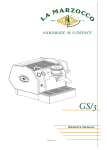

![RUMD User Manual [Version 3.0]](http://vs1.manualzilla.com/store/data/005734566_1-539a984f38202face31c4a646ef91457-150x150.png)



